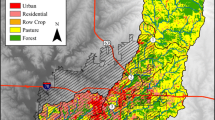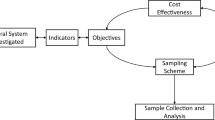Abstract
Paired water samples were simultaneously activated from two different vertical positions within the approach section of a flow-control structure to determine the effect of sample intake position on nonpoint runoff parameter concentrations and subsequent event loads. Suspended solids (SS), total phosphorus (TP) and organic plus exchangeable nitrogen [(Or+Ex)-N] were consistently higher throughout each runoff event when sampled from the floor of the approach section as opposed to those samples taken at midstage. Dissolved molybdate reactive phosphorus (DMRP) and ammonium (NH4-N) concentrations did not appear to be significantly affected by the vertical difference in intake position. However, the nitrate plus nitrite nitrogen [(NO3+NO2)-N] concentrations were much higher when sampled from the midstage position.
Although the concentration differences between the two methods were not appreciable, when evaluated in terms of event loads, discrepancies were evident for all parameters. Midstage sampling produced event loads for SS, TP, (Or + Ex)−N, DMRP, NH4-N, and (NO3+NO2)-N that were 44,39,35,80,71, and 181%, respectively, of floor sampling loads. Differences in loads between the two methods are attributed to the midstage position, sampling less of the bed load. The correct position will depend on the objective; however, such differences should be recognized during the design phase of the monitoring program.
Similar content being viewed by others
Literature cited
Burwell, R. E., G. E. Schumann, R. F. Piest, W. E. Larson, and E. E. Alberts. 1975. Sampling procedure for nitrogen and phosphorus in runoff.Transactions of the American Society of Agricultural Engineering. 18:912–917.
Daniel, T. C., P. E. McGuire, G. D. Bubenzer, F. W. Madison, and J. G. Konrad. 1978. Assessing the pollutional load from nonpoint sources: Planning considerations and a description of an automated water quality monitoring program.Environmental Management 2:55–65.
Holtan, H. N., N. E. Marshall, and L. L. Harrold. 1962.Field Manual for Research in Agricultural Hydrology (Agricultural Handbook No. 224). Soil and Water Conservation Research Division, Agricultural Research Service, Washington, D.C.
U.S. Environmental Protection Agency. 1974.Methods for Chemical Analysis of Water and Wastes. EPA Report No. 625/6-24-003. National Environmental Research Center. Cincinnati, Ohio.
Author information
Authors and Affiliations
Additional information
This work was supported by the Soil Science Department, College of Agriculture and Life Sciences, University of Wisconsin-Madison, and by the U.S. Environmental Protection Agency, Region V., Chicago, Illinois (Grant No. G005139-01).
Rights and permissions
About this article
Cite this article
McGuire, P.E., Daniel, T.C., Stoffel, D. et al. Sample intake position and loading rates from nonpoint source pollution. Environmental Management 4, 73–77 (1980). https://doi.org/10.1007/BF01866222
Issue Date:
DOI: https://doi.org/10.1007/BF01866222




